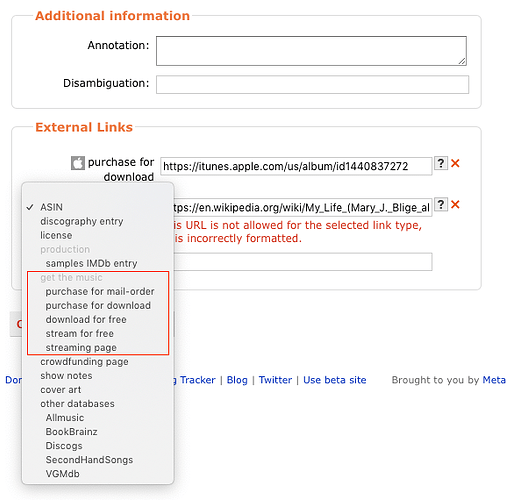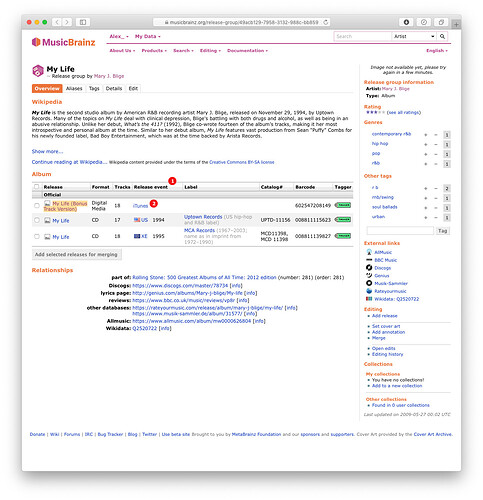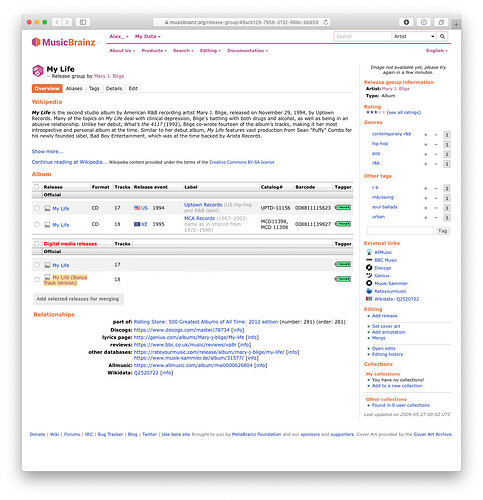I am offering for discussion a mock-up of how the release page of a digital release might look like.
As a way of introduction, I see that external links may suffice to merely indicate that a digital version exists:
But when you decide that digital media should be treated as separate release entities, then I think you might want to devise a separate database scheme, because the details might not fit into the same scheme you use for physical media releases.
The release I used for the mock-up I submitted myself (my very first ![]() ) via a-tisket (and it is still open for votes). Here it is:
) via a-tisket (and it is still open for votes). Here it is:
My explanation for each change (see the numbered red circles):
1 and 4
I moved the link away from “External links” and also renamed it.
First, about renaming:
The global link My Life (Bonus Track Version) - Album by Mary J. Blige - Apple Music should not be named “iTunes US”, rather “iTunes” or “iTunes global”. The “US” link is this one: My Life (Bonus Track Version) - Album by Mary J. Blige - Apple Music. This might seem like an insignificant detail, but is it?
In today’s world, there exists iTunes, Apple Music and Music (the app) - various services to get the same thing. So, this link could just as well be described as “Music” or “Music US”. Thinking of a general description, you’d have to use “Apple US”, or simply “Apple”. Apple after all is the release source for this album.
Second, about external links:
Source information is one thing, whereas an “external link” can be anything else specific to the release, like a corresponding Discogs page. These are two different things though!
Therefore, placing this link under “External links” makes it look like a minor detail, especially if there were more external links.
Placing it under “Release information”, as I did, gives it more relevance over other links.
2 and 3
The release date is not the same as the date an album became available in a store. Releases through Apple come with the original release date, which is important information.
Taking Live by Donny Hathaway as an example, we all know it was not released through Apple in 1972, however the date tells us which original release the digital files correspond with (or were produced from).
Placing this original release date under “Release Events” is simply wrong - something that a-tisket does automatically without warning.
It is too much to ask from an editor to know or research the digital release date. If it is known, as in this case, fine. If not, don’t bother with it.
With physical media, the release date and region are essential data to describe the release event. With digital media, it is different:
The release date may not be known and is probably less significant than availability information.
The geographical region of a digital release seems arbitrary and relatively unimportant. It is the “source” (distribution platform where the files were released) that is more important.
5
Placing country and flag under “Release events” is wrong, because they signify something else: availability.
I realize it would be unwieldy to clutter the page with a long list of countries. Better let a tool like a-tisket by @marlonob generate this information on-demand.
The trouble of determining the release region for a digital release (addressed in this topic by @August_Janse) could be diminished if the question is not “where was this released?” but rather “where was this release noticed?” The second question can be answered easily by the person making an edit. @cbedgar used the annotation field to list the countries, and I suggest using a separate “Availability” tab.
For an example of how it could be used, see the annotation on the release page. I checked US and DE, so that is all I know and will put down. The dates represent “date noticed”.
If another editor comes along and checked for FR availability, he could expand the list. If yet another editor comes along and checked DE, he could update the date or append a date.
In my mind, region data (country and flag) should be discarded from what defines the release event of a digital media release and should be re-associated with “availability”. It is the release source (store) that matters. It is to digital media what country is for physical media. Accordingly, I also re-imagined the release group page:
My explanation (see the numbered red circles):
1 and 2
The column title “Country/Date” becomes “Release event” and a digital media release would be distinguished by its release source.
Release sources then could become entities, like labels, with their own https://musicbrainz.org/source/[id] page.
Applying the mockup to another album
Take a look at this #Relexa example provided by @thwaller in this post. The release events data would be moved to the “Availability” tab. The BR and ES iTunes links would be discarded. Instead, one (and only one) source has to be given under “Release information” - whichever the editor used to get the audio file and/or information about it.
What is still troubling about this whole approach is that basically every digital release in every store on the planet would have to be treated as a separate release… unless you allow only one digital media release per album and then add the sources as links, dispensing with other details like barcodes, quality, etc.





